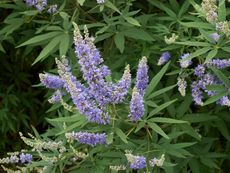Chaste Tree Pruning Info: When And How To Prune A Chaste Tree


Chaste trees (Vitex agnus-castus) get their name from properties of the seed within the edible berries that are said to reduce libido. This property also explains another common name—Monk's pepper. Chaste tree trimming is an important part of caring for the tree. Once you know when and how to prune chaste trees, you can keep them looking neat and blooming all summer.
Chaste Tree Pruning Info
There are several reasons to prune a chaste tree. Left to their own devices, they grow 15 to 20 feet (4.5 to 6 m.) tall and 10 to 15 feet (3 to 4.5 m.) wide, but you can control the size through pruning chaste trees.
You can also control the shape by chaste tree trimming. Carefully placed cuts can encourage the shrub to put on new growth. Another type of pruning, called deadheading, is important to keep chaste trees blooming all summer.
When to Prune Chaste Trees
The best time to prune a chaste tree is in late winter. Even if you've never pruned a tree or shrub before, you can prune a chaste tree. These trees are very forgiving and quickly grow back to cover mistakes. In fact, you can cut off the entire tree at ground level and it will regrow at an astonishing pace.
How to Prune a Chaste Tree
In spring and summer, clip off the spent flowers before they have a chance to go to seed. This allows the plant to put its resources into making flowers rather than nurturing seeds. If you remove the flower spikes throughout the first half of the season, the tree may continue blooming into early fall.
In winter, remove weak, twiggy growth from the center of the plant to keep it looking tidy. This is also the time to prune to encourage branching. Make cuts all the way back to a side branch whenever possible. If you must shorten rather than remove a branch, cut just above a twig or bud.
New growth will take off in the direction of the bud. Pruning chaste trees to remove the lower limbs that droop and hang close to the ground is optional, but if you remove these branches it will make lawn and garden maintenance much easier, and you'll be able to grow ornamentals under the tree.
Gardening tips, videos, info and more delivered right to your inbox!
Sign up for the Gardening Know How newsletter today and receive a free download of our most popular eBook "How to Grow Delicious Tomatoes."

Jackie Carroll has written over 500 articles for Gardening Know How on a wide range of topics.
-
 Urban Beekeeping Guide: Top Tips For Raising Bees In The City
Urban Beekeeping Guide: Top Tips For Raising Bees In The CityUrban beekeeping can be a rewarding and appreciated pastime, but first be sure it’s legal in your city and learn the ropes of beekeeping.
By Mary Ellen Ellis
-
 2024 Plant Of The Year: Why Experts Say Philodendron Is The “It” Plant Of The Year
2024 Plant Of The Year: Why Experts Say Philodendron Is The “It” Plant Of The YearWe aren’t surprised that philodendron was designated the plant of the year. Versatile, easy-care and lovely, it’s the houseplant of the year 2024!
By Bonnie L. Grant
-
 Potted Chaste Tree Care – Learn About Container Grown Chaste Trees
Potted Chaste Tree Care – Learn About Container Grown Chaste TreesChaste trees are one of the easiest flowering trees to grow, even in containers. Click here for more info on growing a chaste tree in a container.
By Laura Miller
-
 Chaste Tree Info: Tips On Chaste Tree Cultivation And Care
Chaste Tree Info: Tips On Chaste Tree Cultivation And CareChaste tree garden care is easy, but there are a few care essentials you need to know. Learn more in this article. Click here to get additional information.
By Jackie Carroll